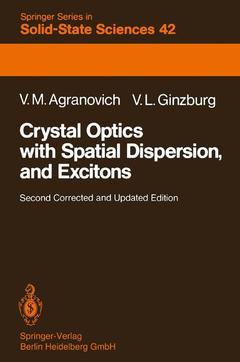Description
Crystal Optics with Spatial Dispersion, and Excitons (2nd Ed., 2nd ed. 1984. Softcover reprint of the original 2nd ed. 1984)
Springer Series in Solid-State Sciences Series, Vol. 42
Authors: Agranovich Vladimir M., Ginzburg V.
Language: English
Keywords
Absorption; Kristalloptik; Räumliche Dispersion; crystal; dispersion; exciton; exziton; optics
Approximative price 52.74 €
In Print (Delivery period: 15 days).
Add to cart
Publication date: 04-2014
447 p. · 15.2x22.9 cm · Paperback
447 p. · 15.2x22.9 cm · Paperback
Description
/li>Contents
/li>
Spatial dispersion, namely, the dependence of the dielectric-constant tensor on the wave vector (i.e., on the wavelength) at a fixed frequency, is receiving increased attention in electrodynamics and condensed-matter optics, partic ularly in crystal optics. In contrast to frequency dispersion, namely, the frequency dependence of the dielectric constant, spatial dispersion is of interest in optics mainly when it leads to qualitatively new phenomena. One such phenomenon has been weH known for many years; it is the natural optical activity (gyrotropy). But there are other interesting effects due to spatial dispersion, namely, new normal waves near absorption lines, optical anisotropy of cubic crystals, and many others. Crystal optics that takes spatial dispersion into account includes classical crystal optics with frequency dispersion only, as a special case. In our opinion, this fact alone justifies efforts to develop crystal optics with spatial dispersion taken into account, although admittedly its influence is smaH in some cases and it is observable only under rather special conditions. Furthermore, spatial dispersion in crystal optics deserves attention from another point as well, namely, the investigation of excitons that can be excited by light. We contend that crystal optics with spatial dispersion and the theory of excitons are fields that overlap to a great extent, and that it is sometimes quite impossible to separate them. It is our aim to show the true interplay be tween these interrelations and to combine the macroscopic and microscopic approaches to crystal optics with spatial dispersion and exciton theory.
1. Introduction.- 2. The Complex Dielectric-Constant Tensor ?ij(?,k) and Normal Waves in a Medium.- 3. The Tensor ?ij(?,k) in Crystals.- 4. Spatial Dispersion in Crystal Optics.- 5. Surface Excitons and Polaritons.- 6. Microscopic Theory. Calculation of the Tensor ?ij(?,k).- 7. Conclusion.- A.1 Crystal-Symmetry Notation.- A.2 Information from Space Group Theory.- A.2.1 Classification of the States of Mechanical Excitons.- Notation.- References.
© 2024 LAVOISIER S.A.S.
These books may interest you

Contemporary Optics 105.49 €



